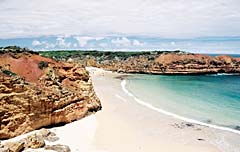
Great Ocean Road
Mt Gambier - Grampians - Great Ocean Road
Click on a picture to enlarge. These pages show only a small selection of the 400 pictures of Australia. Order the CD to view all pictures full screen (800 x 600 pixels) and to enjoy the slide shows with original music! The CD offers you also the complete interactive story, suitable for quick viewing and printing.
When we go back to the rental car office to get our new car
we worry a bit they by now will have noticed the small and not so small bumps
on the roof and the bonnet, resulting  from
the hailstones that surprised us in Esperance. I still feel a bit guilty. Jac
doesn’t feel guilty and doesn’t worry but thinks we could go in disguise. ‘How?’
I wonder and Jac explains we could put on our baseball caps. I laugh at him
and say the woman that helped us will surely recognize us, it is only three
days ago and anyway we are a bit unusual couple because of our age difference
(17 years in case you are wondering, from the pictures you should be able to
guess
from
the hailstones that surprised us in Esperance. I still feel a bit guilty. Jac
doesn’t feel guilty and doesn’t worry but thinks we could go in disguise. ‘How?’
I wonder and Jac explains we could put on our baseball caps. I laugh at him
and say the woman that helped us will surely recognize us, it is only three
days ago and anyway we are a bit unusual couple because of our age difference
(17 years in case you are wondering, from the pictures you should be able to
guess  who
is the older one). Jac claims however that the caps change our appearance a
lot and I’m willing to try it. We hide under the peaks of our caps and enter
the office. The woman (of course it is the same woman) smiles friendly at us
and says: “Ah hello, didn’t you return a car a couple of days ago?” We shrink
visibly but she is very friendly and says nothing about bumps. Taking courage
from this we again decide not to pay the extra insurance for the 17 next days
but to take our 1000 AUD risk. Anyway, what can possibly happen, we now enter
the civilized part of Australia…
who
is the older one). Jac claims however that the caps change our appearance a
lot and I’m willing to try it. We hide under the peaks of our caps and enter
the office. The woman (of course it is the same woman) smiles friendly at us
and says: “Ah hello, didn’t you return a car a couple of days ago?” We shrink
visibly but she is very friendly and says nothing about bumps. Taking courage
from this we again decide not to pay the extra insurance for the 17 next days
but to take our 1000 AUD risk. Anyway, what can possibly happen, we now enter
the civilized part of Australia…
We follow the coast to the South and visit Mount Gambier, a
relatively big city build on the slopes 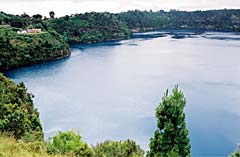 of
the extinct volcano called – as you guessed – Mount Gambier. Our camping is
close to the center of the city and lays next to three craters, very strange
so nearby the middle of a city like a kind of enormous park that got a little
out of hand. One of the craters has a lake that is famous for its very deep
blue color and appropriately named the ‘Blue Lake’. The lake is 85 meters deep
and has indeed an extremely saturated dark blue color, even in the rain when
we expect everything to be gray (like in Holland). We read in our Lonely Planet
that the lake is indeed in winter but changes somewhere in November in only
a couple of days to blue. This seems to have something to do with the temperature
of the water.
of
the extinct volcano called – as you guessed – Mount Gambier. Our camping is
close to the center of the city and lays next to three craters, very strange
so nearby the middle of a city like a kind of enormous park that got a little
out of hand. One of the craters has a lake that is famous for its very deep
blue color and appropriately named the ‘Blue Lake’. The lake is 85 meters deep
and has indeed an extremely saturated dark blue color, even in the rain when
we expect everything to be gray (like in Holland). We read in our Lonely Planet
that the lake is indeed in winter but changes somewhere in November in only
a couple of days to blue. This seems to have something to do with the temperature
of the water.
I see a tower standing on the highest point next to the other
crater. When I see a high point I like to go there if possible and a lot is
possible if you want it! Jac surprisingly doesn’t  complain
– somewhat later I understand why: a road goes almost straight to the top. Only
the last part we have to walk and we walk as fast as possible, it is dry on
the moment but very dark clouds gather above our heads. On the highest point
we have a beautiful view over the three craters, two of them with lakes. I try
to photograph the wide view but the haze and the clouds closing in prevent a
real nice picture. We hear a lot of panting coming closer and are joined by
a family of four other Dutch people.
complain
– somewhat later I understand why: a road goes almost straight to the top. Only
the last part we have to walk and we walk as fast as possible, it is dry on
the moment but very dark clouds gather above our heads. On the highest point
we have a beautiful view over the three craters, two of them with lakes. I try
to photograph the wide view but the haze and the clouds closing in prevent a
real nice picture. We hear a lot of panting coming closer and are joined by
a family of four other Dutch people. 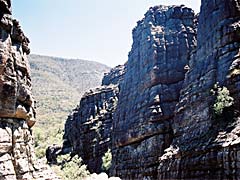 Always
funny to listen to Dutch people chattering away, ignoring the possibility that
somebody actually could understand them. I have a lot of experience with this
myself, especially in New Zealand I commented a lot about New Zealanders standing
next to us who suddenly appeared to understand Dutch perfectly, immigrated when
they were seven years old or so with their parents to New Zealand and now speaking
English in a surely non-Dutch way (as soon as we utter one word everybody knows
we come from Holland, although almost nobody knows where exactly that may be).
This can be quite humiliating so I say something in Dutch to the family. ‘How
surprising to meet you exactly here on top of the other side of the world!’
the man of the family says philosophically. I answer that he wouldn’t have been
very surprised to meet us in Holland. It starts to rain heavily.
Always
funny to listen to Dutch people chattering away, ignoring the possibility that
somebody actually could understand them. I have a lot of experience with this
myself, especially in New Zealand I commented a lot about New Zealanders standing
next to us who suddenly appeared to understand Dutch perfectly, immigrated when
they were seven years old or so with their parents to New Zealand and now speaking
English in a surely non-Dutch way (as soon as we utter one word everybody knows
we come from Holland, although almost nobody knows where exactly that may be).
This can be quite humiliating so I say something in Dutch to the family. ‘How
surprising to meet you exactly here on top of the other side of the world!’
the man of the family says philosophically. I answer that he wouldn’t have been
very surprised to meet us in Holland. It starts to rain heavily.
Since the weather shows little intention to improve, we leave
the coast and drive to the Grampians, attractive mountains to the north-east
of Mt Gambier, west of Melbourne. 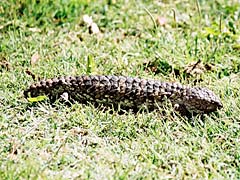 Surprisingly
in the Grampians, 150 kilometer away from the coast, the weather is good: sun
and a nice temperature. We camp in a totally Jac approved camping, close to
the place Halls Gap where we can buy food. The camping is beautifully situated
in the woods next to a little stream in the center of the park, this is the
so-called ‘Wonderland Range’. The place certainly deserves this name with its
fantastic sandstone formations, impressing waterfalls and lots of trees and
colorful plants. To watch the wildlife you don’t need to leave the camping.
Surprisingly
in the Grampians, 150 kilometer away from the coast, the weather is good: sun
and a nice temperature. We camp in a totally Jac approved camping, close to
the place Halls Gap where we can buy food. The camping is beautifully situated
in the woods next to a little stream in the center of the park, this is the
so-called ‘Wonderland Range’. The place certainly deserves this name with its
fantastic sandstone formations, impressing waterfalls and lots of trees and
colorful plants. To watch the wildlife you don’t need to leave the camping.
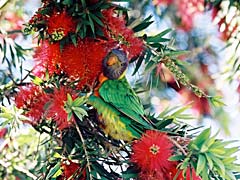 I
see many parrots and Rosella’s and when I try to photograph them up high in
the trees next to the stream, I almost step on an archaic type of lizard, half
a meter long with strange big scales. Our neighbor on the camping who lives
here permanently, impresses me with a dangerous but dead tiger snake, which
he found yesterday in his tool shed. Rainbow lorikeets hide in shrubs with brilliant
red flowers. Every morning a new tree is the favorite, the lorikeets eat the
nectar of the flowers. I hear them happily piping but it is difficult to see
them and even worse to make a photograph. When you see a rainbow lorikeet sitting
in a cage, the lorikeet colored green, red, yellow, orange and blue, you wonder
what possibly the idea behind al this colors can be. You understand better when
you see – or rather: don’t see - the lorikeet in these red flowered green shrubs.
I
see many parrots and Rosella’s and when I try to photograph them up high in
the trees next to the stream, I almost step on an archaic type of lizard, half
a meter long with strange big scales. Our neighbor on the camping who lives
here permanently, impresses me with a dangerous but dead tiger snake, which
he found yesterday in his tool shed. Rainbow lorikeets hide in shrubs with brilliant
red flowers. Every morning a new tree is the favorite, the lorikeets eat the
nectar of the flowers. I hear them happily piping but it is difficult to see
them and even worse to make a photograph. When you see a rainbow lorikeet sitting
in a cage, the lorikeet colored green, red, yellow, orange and blue, you wonder
what possibly the idea behind al this colors can be. You understand better when
you see – or rather: don’t see - the lorikeet in these red flowered green shrubs.
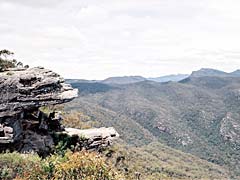 We
walk the ‘Wonderland loop’, a walk of 10 kilometer which shows us all interesting
Wonderland places: the Venus Baths where the water of the Stony Creek slowly
flows over large flat stones, the Splitter Falls, not high but attractive with
its different streams, the Grand Canyon which is not so big as the name suggests
but has almost vertical walls which we have to climb. We pass through ‘Silent
Street’, a road in between high walls, not so silent since we meet lots of people.
West Australia was much quieter than Victoria. Finally we reach the Pinnacle
rock and have a grand view over the valley deep below. The climb down is very
steep but not to difficult, a wonderful walk through Wonderland!
We
walk the ‘Wonderland loop’, a walk of 10 kilometer which shows us all interesting
Wonderland places: the Venus Baths where the water of the Stony Creek slowly
flows over large flat stones, the Splitter Falls, not high but attractive with
its different streams, the Grand Canyon which is not so big as the name suggests
but has almost vertical walls which we have to climb. We pass through ‘Silent
Street’, a road in between high walls, not so silent since we meet lots of people.
West Australia was much quieter than Victoria. Finally we reach the Pinnacle
rock and have a grand view over the valley deep below. The climb down is very
steep but not to difficult, a wonderful walk through Wonderland!
The next day we 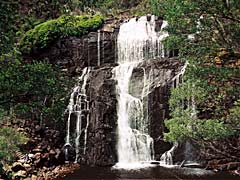 visit
the impressive Boroda lookout from where you see the whole of the valley with
the lake, Halls Gap and the mountains with the Pinnacle where we walked yesterday,
it looks quite low from here. We drive on to the Reeds lookout with the ‘Jaws
of Death’ – a pity you aren’t allowed any more to sit in between the ‘Jaws’,
probably the park rangers worry that some heavy tourist together with the lower
Jaw will disappear in the sheer depth… Finally we visit the spectacular MacKenzie
falls, extremely high, try and find Jac at the left bottom of the falls on the
picture. After our walk yesterday it took us some time to climb the stairs back
up!
visit
the impressive Boroda lookout from where you see the whole of the valley with
the lake, Halls Gap and the mountains with the Pinnacle where we walked yesterday,
it looks quite low from here. We drive on to the Reeds lookout with the ‘Jaws
of Death’ – a pity you aren’t allowed any more to sit in between the ‘Jaws’,
probably the park rangers worry that some heavy tourist together with the lower
Jaw will disappear in the sheer depth… Finally we visit the spectacular MacKenzie
falls, extremely high, try and find Jac at the left bottom of the falls on the
picture. After our walk yesterday it took us some time to climb the stairs back
up!
From the Grampians we drive back to the coast again, to Warrnambool
where the ‘Great Ocean Road’ starts. 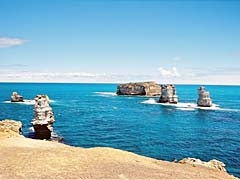 The
‘Great Ocean Road’, famous for its spectacular coastal views, runs from Warrnambool
up to Torquay (or vice versa if you start in Melbourne, 100 km west from Torquay).
We have beautiful weather, the sun colors the ocean all shades of blue and green
and the strangely formed limestone rocks are radiantly yellow white. We camp
in Port Campbell in Port Campbell National Park. Jac thinks it time after one
month of holiday for at least one day of real holiday: doing nothing except
laying in the sun and maybe take a swim and drink some beer. I planned already
a small stroll but think it wiser not to mention this. Since
The
‘Great Ocean Road’, famous for its spectacular coastal views, runs from Warrnambool
up to Torquay (or vice versa if you start in Melbourne, 100 km west from Torquay).
We have beautiful weather, the sun colors the ocean all shades of blue and green
and the strangely formed limestone rocks are radiantly yellow white. We camp
in Port Campbell in Port Campbell National Park. Jac thinks it time after one
month of holiday for at least one day of real holiday: doing nothing except
laying in the sun and maybe take a swim and drink some beer. I planned already
a small stroll but think it wiser not to mention this. Since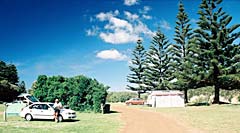 it is beautiful weather we indeed spend the whole day on the beach of Port Campbell,
a proper beach with lots of sand which we humans have to share with masses of
seagulls. The water is very cold but refreshing and I have to admit one day
doing nothing is very relaxing, although no amount of sun block protects properly
against the strong Australian sun so the next day I’m all shades of pink. Jac
doesn’t use sun block – some kind of principle like never wearing a belt in
his car, luckily not using sun block is no offense yet – and has no problem
at all, “You see what happens when you use that stuff” he says with a triumphant
smile.
it is beautiful weather we indeed spend the whole day on the beach of Port Campbell,
a proper beach with lots of sand which we humans have to share with masses of
seagulls. The water is very cold but refreshing and I have to admit one day
doing nothing is very relaxing, although no amount of sun block protects properly
against the strong Australian sun so the next day I’m all shades of pink. Jac
doesn’t use sun block – some kind of principle like never wearing a belt in
his car, luckily not using sun block is no offense yet – and has no problem
at all, “You see what happens when you use that stuff” he says with a triumphant
smile.
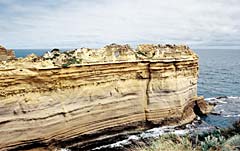 The
next two days we look around in Port Campbell National Park with its dramatic
limestone cliffs with gorges, grotto’s, arches and blowholes. The rocks consist
of a mixture of limestone and clay. The water of the sea, the spray of the sea
and the rainwater attack
The
next two days we look around in Port Campbell National Park with its dramatic
limestone cliffs with gorges, grotto’s, arches and blowholes. The rocks consist
of a mixture of limestone and clay. The water of the sea, the spray of the sea
and the rainwater attack 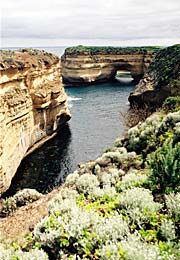 the
layers of limestone and clay, which erode in different rates. The Gibson Steps
lead down to Gibson Beach, a very dangerous beach, from where you can see how
high the steep cliffs really are. The 12 Apostles, probably the most famous
place of the Great Ocean Road and visited by many tourist, features a
the
layers of limestone and clay, which erode in different rates. The Gibson Steps
lead down to Gibson Beach, a very dangerous beach, from where you can see how
high the steep cliffs really are. The 12 Apostles, probably the most famous
place of the Great Ocean Road and visited by many tourist, features a 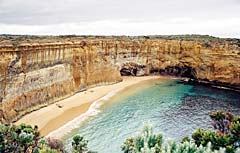 view
on the coast with the former 12 Apostles, lonely rocks in the sea. By now there
are only some 7 Apostles left, the others collapsed in the sea. Originally the
place was called ‘The sow and the piglets’, I presume because of the rocks sticking
out towards sea (tits of the sow) to the single rocks (piglets) who were long
ago connected. But this name was presumably not dignified enough, so they changed
it to 12 Apostles.
view
on the coast with the former 12 Apostles, lonely rocks in the sea. By now there
are only some 7 Apostles left, the others collapsed in the sea. Originally the
place was called ‘The sow and the piglets’, I presume because of the rocks sticking
out towards sea (tits of the sow) to the single rocks (piglets) who were long
ago connected. But this name was presumably not dignified enough, so they changed
it to 12 Apostles.
Loch Ard Gorge I  found
the most beautiful place of Port Campbell National Park and indeed of the whole
Great Ocean Road. Loch Ard Gorge is the place where in 1878 the Loch Ard shipwrecked,
only 2 people survived. By day with a quiet blue sea the place looks fairly
innocent, although the gorge is steep and the beaches can only be reached by
sea, surrounded as they are by tall cliffs. The soft yellow light of the late
afternoon accentuates the different colors of each layer of the cliffs: yellow,
white, dark red, gray. We visit the place again the following morning, the area
is big and you can easily spend half a day over here.
found
the most beautiful place of Port Campbell National Park and indeed of the whole
Great Ocean Road. Loch Ard Gorge is the place where in 1878 the Loch Ard shipwrecked,
only 2 people survived. By day with a quiet blue sea the place looks fairly
innocent, although the gorge is steep and the beaches can only be reached by
sea, surrounded as they are by tall cliffs. The soft yellow light of the late
afternoon accentuates the different colors of each layer of the cliffs: yellow,
white, dark red, gray. We visit the place again the following morning, the area
is big and you can easily spend half a day over here.
The Great Ocean Road features 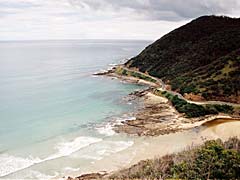 not
only a beautiful coast but also two nature parks, both with large woods: Otway
National Park where we saw Koala’s up high in the trees and Angahook-Lorne State
Park, where we walked along the St George River and saw a cormorant, a kingfisher
and two ducks sharing a branch sticking out over the river. Furthermore we saw
kangaroos and an echidna, a kind of hedgehog with a long snout, handy for eating
ants.
not
only a beautiful coast but also two nature parks, both with large woods: Otway
National Park where we saw Koala’s up high in the trees and Angahook-Lorne State
Park, where we walked along the St George River and saw a cormorant, a kingfisher
and two ducks sharing a branch sticking out over the river. Furthermore we saw
kangaroos and an echidna, a kind of hedgehog with a long snout, handy for eating
ants.
Around Apollo Bay the coast changes its character and the high
cliffs 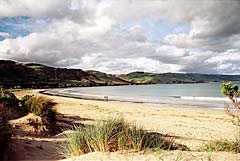 make
place for green slopes and ranges of dunes. Here you find long beaches very
suitable for surfing. Apollo Bay, Lorne and Aireys Inlet are nice places to
visit, real tourist places but especially Lorne is very charming with its small
shops and beautiful houses. We drive on to Melbourne.
make
place for green slopes and ranges of dunes. Here you find long beaches very
suitable for surfing. Apollo Bay, Lorne and Aireys Inlet are nice places to
visit, real tourist places but especially Lorne is very charming with its small
shops and beautiful houses. We drive on to Melbourne.
Back to Virtual Traveling home